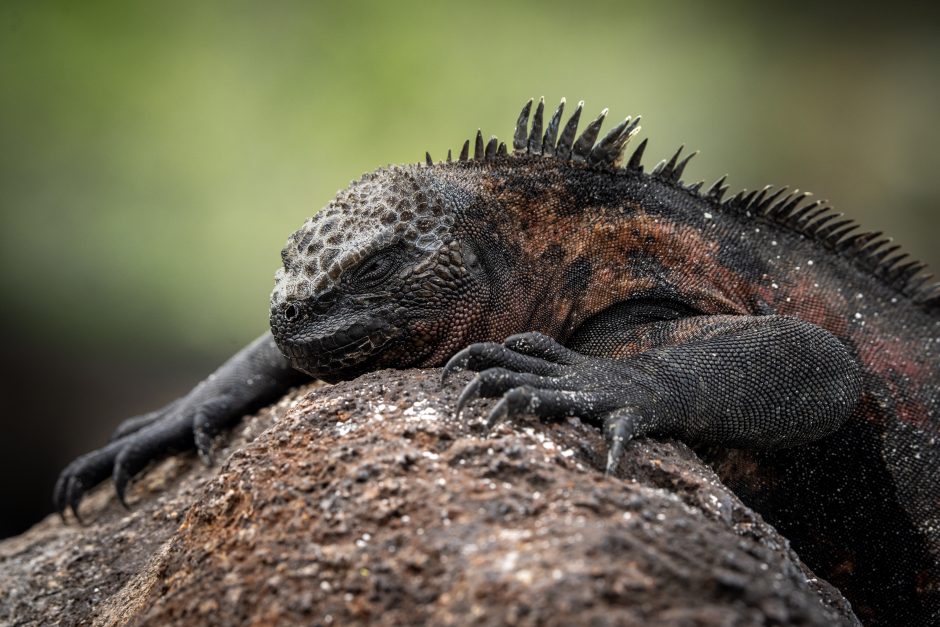
Previsualization – The Art of Picturing your Pictures
One of the biggest things that I think separates a tourist with a camera from an amateur/pro-level photographer is planning. If you’re like me, then you probably think about the photos you’re going to take before ever leaving the house. This planning ahead is known in the photography and film world as Previsualization. Experienced photographers will come on a tour or vacation with a wish list of images they hope to take.
You probably already do this to a certain extent. It’s often the reason why photographers choose to go on a trip in the first place. “I’d love to get a picture of a giant tortoise, let’s go to the Galapagos!” Heck, if you go outside to take pictures at sunset, instead of at 3pm, then you are previsualizing. “I know the place I want to take pictures will look the best when the light is perfect at sunset.”
This post will detail how I took the concept of my own expedition to the Galapagos (or even a quick trip to the local park) and previsualized it into a shot list that I could follow to increase my chances of getting the images I’d be happy with.
Research
One of the first things I do when I know I’m traveling to a new location is to do an image search online. Type in the spots you’ll visit or the wildlife you hope to see. This is super helpful because it’ll show you what other photographers were able to get, potentially highlight locations and compositions to keep an eye out for and spark some inspiration in what you yourself might want to capture.
When looking online at other photographer’s work, you’ll have to ask yourself “Do I want to replicate (or hopefully improve on) what they’ve done OR do I want to steer clear of the usual shots to show my own photographic voice?” There is value in both answers. I find it a great exercise to try and replicate certain shots, especially when it comes to famous photographers like Ansel Adams. It can be quite humbling, but also fun to try to imitate a well-known image from your favorite photographer (to photograph in their footsteps if you will). Equally, if you want to stand out from the crowded photography community, it can be challenging, but invigorating to force yourself to look beyond the images everyone gets and find something creative and new.
If you’re planning on going with a travel company, their own trip’s webpage will host a series of photos from the location. Look at this photo trip to the Galapagos. Do you want to try to get some of these shots yourself?
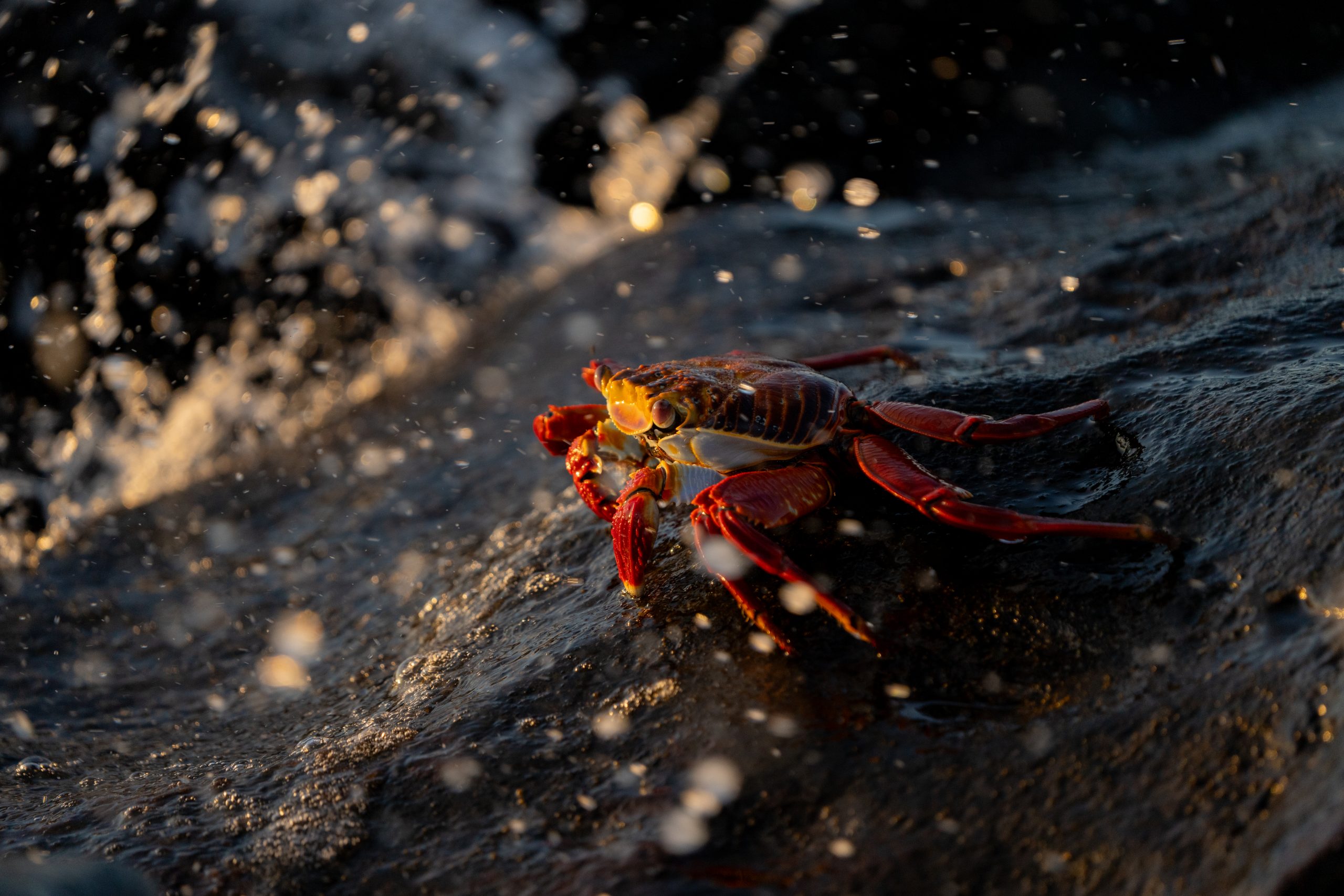
This shot of a Sally Lightfoot Crab was born out of previsualization. I had seen photo after photo online of these crabs, which led me to believe they were common in the Galapagos. There were a lot of crab shots that photographers had already gotten: red crabs on contrasting black lava rock or close-up crab portraits that show off their brilliant colors. In this instance, I was looking to take what I had seen and elevate it, so this is where I decided to try to get a picture of the crab close to the tideline with the ocean spray blurred to add a bit of drama (the fact I found this at sunset was a bonus).
Build Your Shot List
As you look at all those images online, take note of the subjects, locations, and compositions that interest you. This list is the beginning of the shots that you hope to get while there. Like a photographic to-do list, a Shot List is a written plan that can help you immensely by reminding you what your goals are and ensure that you come home with all the images that inspired you to take the trip in the first place.
Spend some time dreaming up some new images now that you have a better idea of what’s possible. Identify the elements you want to be in each of your photographs and as I mentioned earlier, it is important in translating your photographic style to the trip. Is there a photographic story you want to tell?
Below is the shot list that I built ahead of traveling to the Galapagos Islands. I should note that I went for 2 weeks and visited 17 islands, so your list may not be as extensive or ambitious depending on the length & itinerary of your trip. I kept my list on my phone as a to-do list, so it was always handy (and quite fun to check off each shot as I got it!)
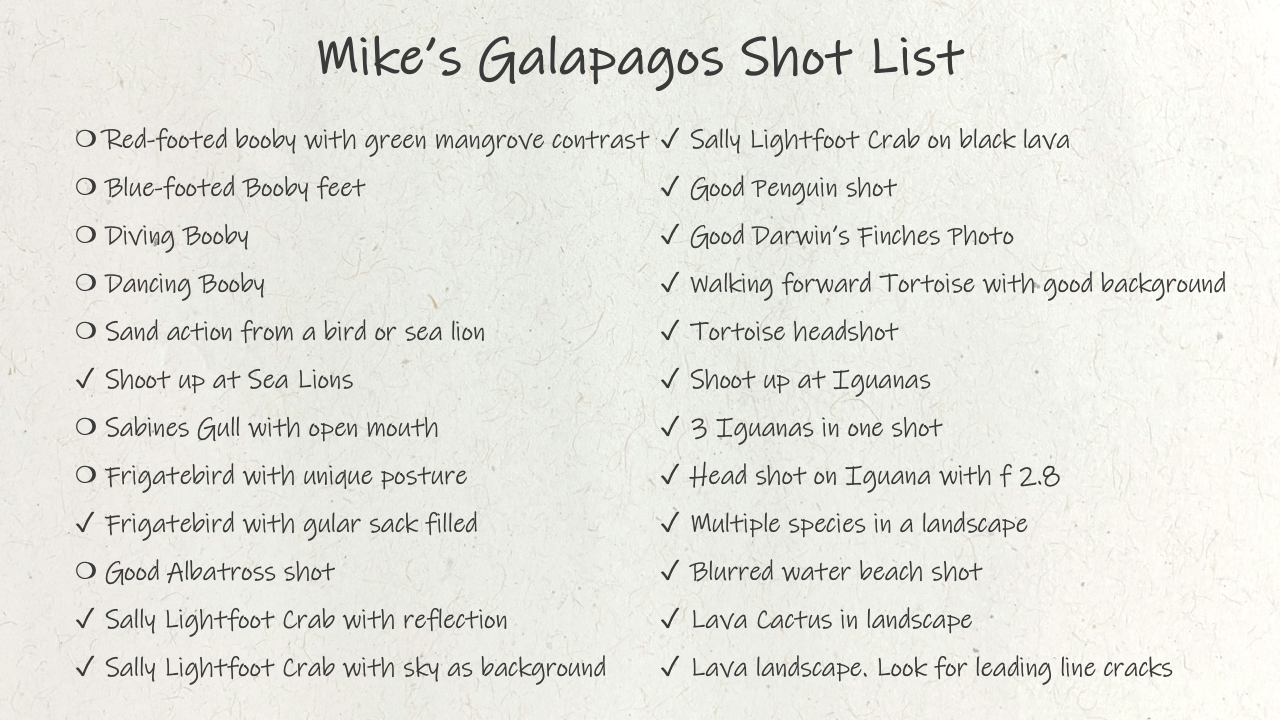
As you can see, I didn’t get every shot I wanted, but unless you’re being paid to photograph the location, then that’s perfectly fine. It’s likely I would have needed ANOTHER 2 weeks to finish off the last few shots (another 2 weeks photographing in the Galapagos just sounds horrible, doesn’t it?) That’s why many professional nature and travel photographers are on assignment for so long. It takes time for the weather to be just right and the wildlife to be in just the right place.
Working with your Shot List
Now that you have your shot list, it can be useful beyond a to-do list. For example, there’s that age-old question: What camera equipment should I pack? If many of the shots are wildlife, then you’ll likely want a zoom lens. Conversely, if there’s an epic landscape location, then you’ll want a wide angle capable of zooming out and capturing the full scene. Planning for a beautiful shot of the milky way at night? Then you’ll need a tripod. The list goes on, but you can see how identifying the images you’d like to get can tell what you should bring to get them.
Once you’re on the trip, keep referring to the shot list so you can be on the lookout for those moments each day. Make your photographic goals known to the guide or the driver, so they can help find those photographic opportunities too. That being said, it’s important to not sound overly needy as demanding too much on a trip can leave a bad impression on your leader as well as others traveling with you which can make your trip a lot less fun.
As I alluded to earlier, you must understand you won’t get all the shots. Often the reason why certain images become famous or coveted is because they are rare. There’s only so many times lightning will strike next to a rainbow. By doing some research into understanding what’s a rare shot and what’s possible, you’ll better prepare yourself mentally if that shot remains unchecked on your list after you head home. Persistence can pay off though and if you have the time to spend in a location to wait for the Galapagos Finch to use its famous beak, then go for it!
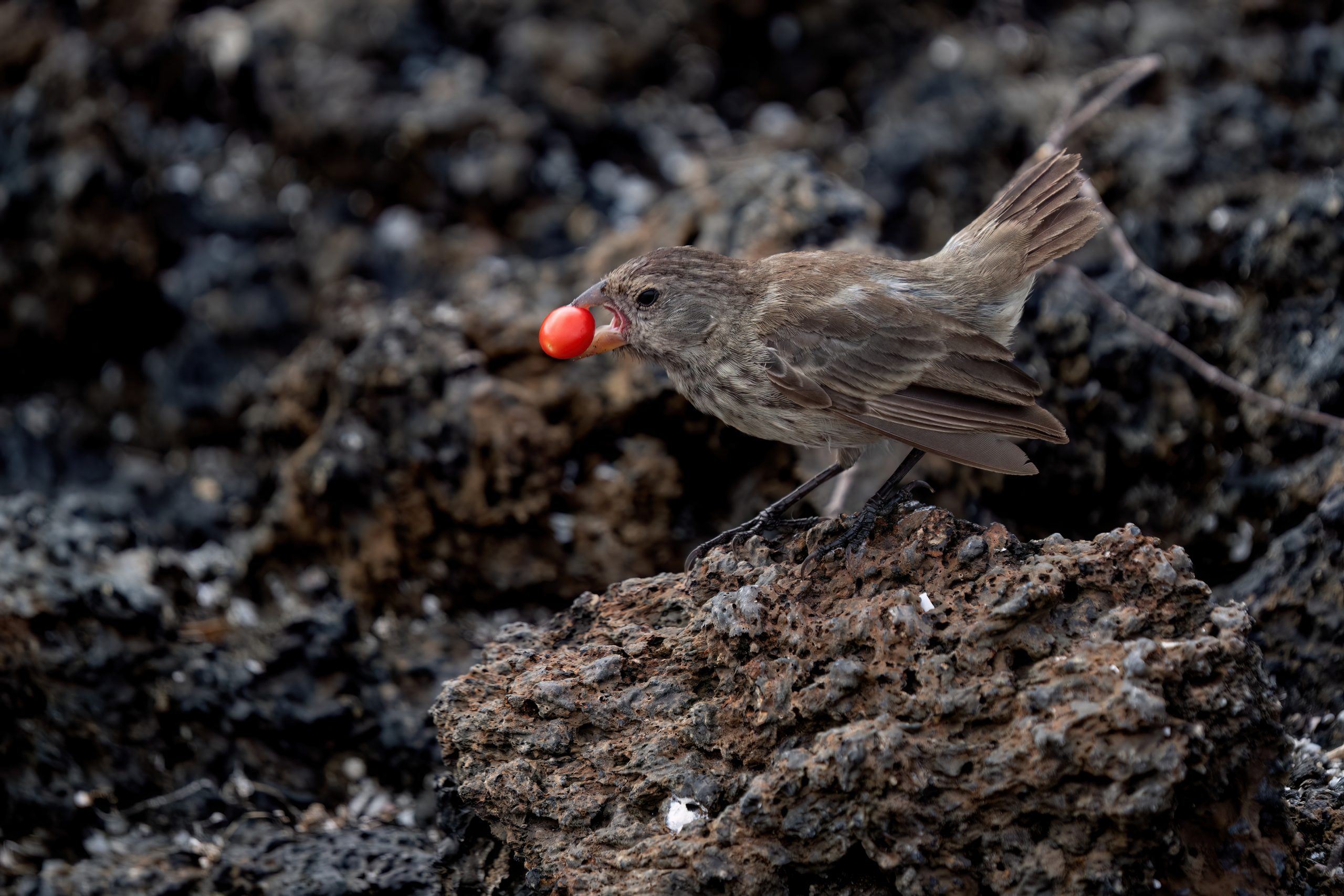
Also, your shot list shouldn’t feel too much like homework. It’s your vacation after all! There are times when you’ll want to stray away from what you previsualized. It’s impossible to know everything about a destination and every shot that is likely before you show up. New photographic elements may pop up and you may want to chase those interesting school bus yellow Land Iguanas you knew very little about before coming. Don’t be so set on your shot list that you miss out on experimenting with something new.
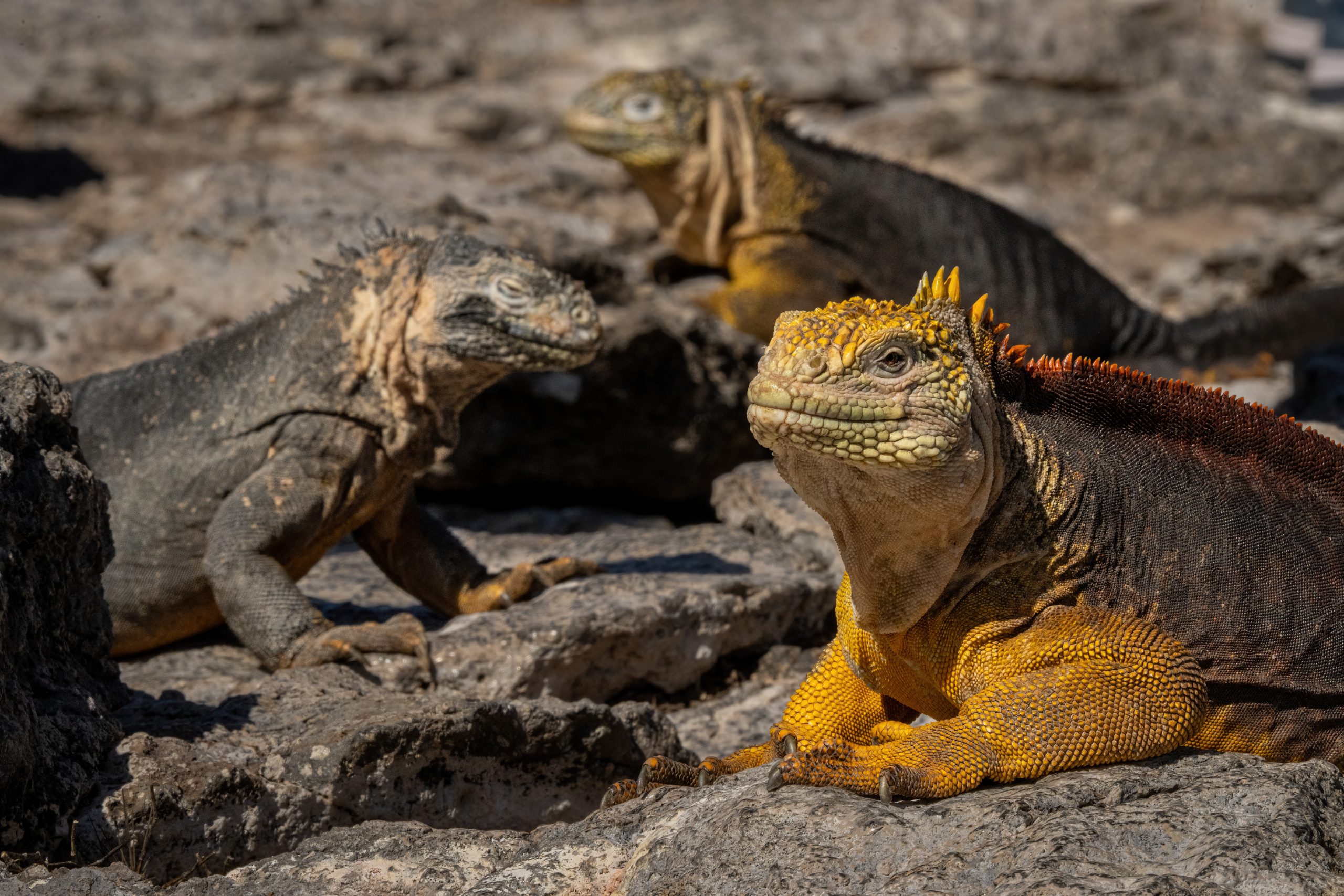
All in all, previsualization is a great skill to develop as you grow as a photographer. You’ll greatly maximize the photo opportunities out in the field and come home with a much better collection of images. Maybe you’ll even finally make a big print of your work to display in your house. My image of a Marine Iguana that starts off this article now graces the wall of my living room and was a shot I’d wanted before ever going to the Enchanted Islands.
Hopefully, I’ve given you some food for thought and I’ll now leave you with a quote on previsualization from the photographic master himself, Ansel Adams.
“The concept of the photograph precedes the operation of the camera.”
Happy Photographing,

Leave a reply